Related Research Articles
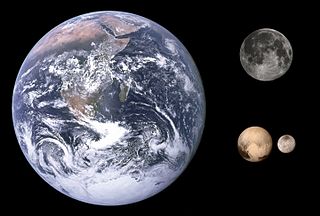
In astronomy, a double planet is a binary satellite system where both objects are planets, or planetary-mass objects, that share an orbital axis external to both planetary bodies.
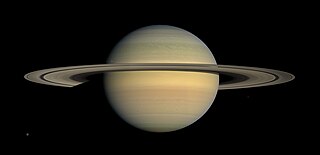
Saturn is the sixth planet from the Sun and the second-largest in the Solar System, after Jupiter. It is a gas giant with an average radius of about nine-and-a-half times that of Earth. It has only one-eighth the average density of Earth, but is over 95 times more massive. However, even though Saturn is nearly the size of Jupiter, Saturn has less than one-third of Jupiter's mass.

A natural satellite is, in the most common usage, an astronomical body that orbits a planet, dwarf planet, or small Solar System body. Natural satellites are colloquially referred to as moons, a derivation from the Moon of Earth.
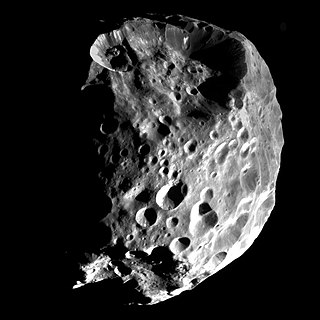
Phoebe is the most massive irregular satellite of Saturn with a mean diameter of 213 km (132 mi). It was discovered by William Henry Pickering on 18 March 1899 from photographic plates that had been taken starting on 16 August 1898 at the Boyden Station of the Carmen Alto Observatory near Arequipa, Peru, by DeLisle Stewart. It was the first satellite to be discovered photographically.

The timeline of discovery of Solar System planets and their natural satellites charts the progress of the discovery of new bodies over history. Each object is listed in chronological order of its discovery, identified through its various designations, and the discoverer(s) listed.

The moons of Saturn are numerous and diverse, ranging from tiny moonlets only tens of meters across to the enormous Titan, which is larger than the planet Mercury. There are 146 moons with confirmed orbits, the most of any planet in the solar system. This number does not include the many thousands of moonlets embedded within Saturn's dense rings, nor hundreds of possible kilometer-sized distant moons that were seen through telescopes but not recaptured. Seven Saturnian moons are large enough to have collapsed into a relaxed, ellipsoidal shape, though only one or two of those, Titan and possibly Rhea, are currently in hydrostatic equilibrium. Three moons are particularly notable. Titan is the second-largest moon in the Solar System, with a nitrogen-rich Earth-like atmosphere and a landscape featuring river networks and hydrocarbon lakes. Enceladus emits jets of ice from its south-polar region and is covered in a deep layer of snow. Iapetus has contrasting black and white hemispheres as well as an extensive ridge of equatorial mountains among the tallest in the solar system.

Skathi, also named Saturn XXVII and originally spelled Skadi, is a natural satellite of the planet Saturn. Skathi is one of Saturn's irregular moons, in its Norse group of satellites. It was discovered on September 23, 2000, by a team of astronomers led by Brett Gladman. The team announced their discovery on December 7, 2000, along with seven other satellites of Saturn, namely; Tarvos, Ijiraq, Thrymr, Siarnaq, Mundilfari, Erriapus, and Suttungr. The moon was named after Skaði, a figure in Norse mythology, as part of an effort to diversify the largely Greek and Roman names of astronomical objects.
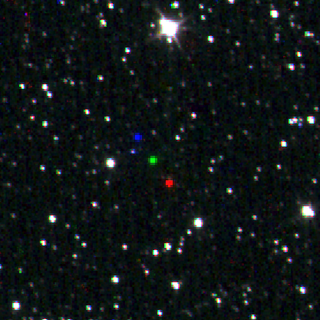
Siarnaq, also designated Saturn XXIX, is the second-largest irregular moon of Saturn. It was discovered on 23 September 2000 by a team of astronomers led by Brett J. Gladman. It was named after the Inuit goddess of the sea, Siarnaq, who is more commonly known as Sedna. Siarnaq is the largest member of Saturn's Inuit group of prograde irregular moons, which orbit far from Saturn in the same direction as the planet's rotation. The moons of the Inuit group are believed to have originated as fragments from the collisional breakup of a larger progenitor moon after it was gravitationally captured into orbit around Saturn several billion years ago. Several other small Inuit group moons share similar orbits to Siarnaq, indicating that the moon had experienced another collision after forming from its progenitor.
The naming of moons has been the responsibility of the International Astronomical Union's committee for Planetary System Nomenclature since 1973. That committee is known today as the Working Group for Planetary System Nomenclature (WGPSN).
S/2004 S 12 is a natural satellite of Saturn. Its discovery was announced by Scott S. Sheppard, David C. Jewitt, Jan Kleyna, and Brian G. Marsden on 4 May 2005 from observations taken between 12 December 2004 and 9 March 2005.
S/2004 S 13 is a natural satellite of Saturn. Its discovery was announced by Scott S. Sheppard, David C. Jewitt, Jan Kleyna, and Brian G. Marsden on 4 May 2005 from observations taken between 12 December 2004 and 9 March 2005.

The Norse group is a large group of retrograde irregular satellites of Saturn. Their semi-major axes range between 12 and 27 Gm, their inclinations between 136° and 178° and their eccentricities between 0.06 and 0.63. Unlike the Inuit and Gallic groups, the orbital parameters are widely dispersed and the group is likely to be composed from a number of subgroups with more homogeneous orbital and physical parameters. The International Astronomical Union (IAU) reserves names taken from Norse mythology for these moons. The exception is Phoebe, the largest, which was discovered long before the others.
S/2006 S 1 is a natural satellite of Saturn. Its discovery was announced by Scott S. Sheppard, David C. Jewitt, Jan Kleyna, and Brian G. Marsden on June 26, 2006 from observations taken between January 4 and April 30, 2006. S/2006 S 1 is about 6 kilometres in diameter, and orbits Saturn at an average distance of 18.65 Gm in 951.1 days, at an inclination of 154.6° to the ecliptic, in a retrograde direction and with an eccentricity of 0.0814.
S/2006 S 3 is a natural satellite of Saturn. Its discovery was announced by Scott S. Sheppard, David C. Jewitt, Jan Kleyna, and Brian G. Marsden on June 26, 2006 from observations taken between January and April 2006.
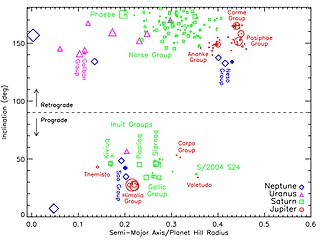
In astronomy, an irregular moon, irregular satellite, or irregular natural satellite is a natural satellite following a distant, inclined, and often highly elliptical and retrograde orbit. They have been captured by their parent planet, unlike regular satellites, which formed in orbit around them. Irregular moons have a stable orbit, unlike temporary satellites which often have similarly irregular orbits but will eventually depart. The term does not refer to shape; Triton, for example, is a round moon but is considered irregular due to its orbit and origins.
S/2007 S 2 is a natural satellite of Saturn. Its discovery was announced by Scott S. Sheppard, David C. Jewitt, Jan Kleyna, and Brian G. Marsden on May 1, 2007, from observations taken between January 18 and April 19, 2007. S/2007 S 2 is about 6 kilometres in diameter, and orbits Saturn at an average distance of 16,054,500 kilometres in 759.2 days, at an inclination of 176.65° to the ecliptic, in a retrograde direction and with an eccentricity of 0.237. According to Denk et al. (2018), it is presumably at high risk of colliding with Phoebe in the future.
S/2006 S 9 is a natural satellite of Saturn. Its discovery was announced by Scott S. Sheppard, David C. Jewitt, Jan Kleyna, Edward Ashton, Brett J. Gladman, Jean-Marc Petit and Mike Alexandersen on May 3, 2023 from observations taken between February 1, 2006 and July 1, 2021.
S/2006 S 19 is a natural satellite of Saturn. Its discovery was announced by Scott S. Sheppard, David C. Jewitt, Jan Kleyna, Edward Ashton, Brett J. Gladman, Jean-Marc Petit and Mike Alexandersen on May 15, 2023 from observations taken between January 5, 2006 and July 9, 2021.
References
- 1 2 "Planetary Satellite Mean Elements". Jet Propulsion Laboratory. California Institute of Technology. Retrieved 23 May 2023.
- 1 2 "MPEC 2023-K118 : S/2006 S 20". Minor Planet Electronic Circular. Minor Planet Center. Retrieved 23 May 2023.
- ↑ "S/2006 S 20 – Tilmann Denk" . Retrieved 2024-01-19.